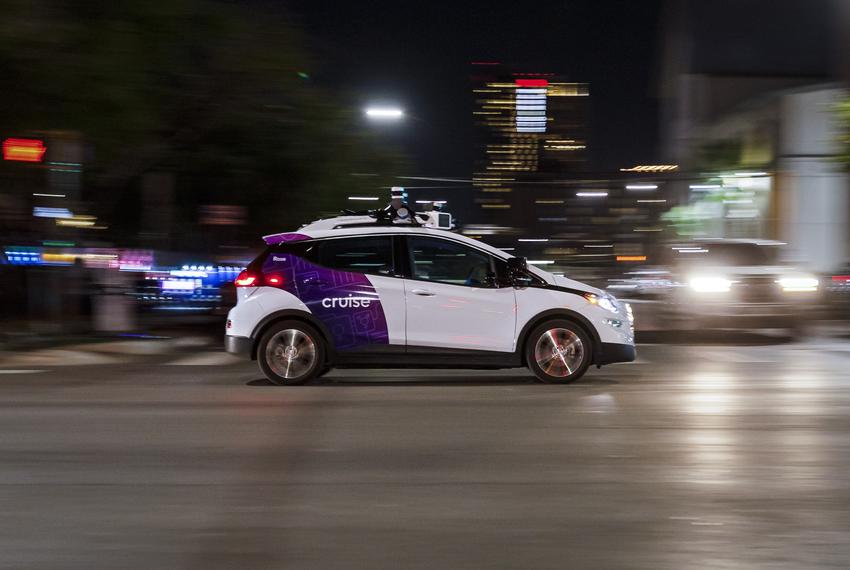Driverless cars are multiplying on Texas roads. Here’s what you should know.

Sign up for The Brief, The Texas Tribune’s daily newsletter that keeps readers up to speed on the most essential Texas news.
It’s 8 p.m. in downtown Austin, and the electric cars silently exit the parking lot one by one — but no one is behind the wheel of any of them. The Cruise depot is full of people preparing the cars for another night of road testing.
There are about 125 autonomous vehicles, or AVs, operating in Austin, according to a city Transportation and Public Works Department memorandum.
It’s unclear how many are operating statewide. According to the Texas Department of Transportation, multiple companies are testing and operating driverless vehicles “as passenger, freight and personal delivery devices” all over the state. The list includes Kodiak, Aurora, Waabi, Torc, Plus.AI, Gatik, Cruise, Volkswagen, Waymo, Starship, Kiwibot, Coco, Refraction.AI, Nuro, and Clevon.
Here’s what you need to know about driverless vehicles in Texas.
When did driverless vehicles become legal in Texas?
Senate Bill 2205, which took effect in September 2017, set the ground rules to regulate AVs in the state.
State Sen. Robert Nichols, R-Jacksonville and chair of the Senate Transportation Committee, said that around six years ago, “pretty much all of the car manufacturers that you can imagine (came) saying we do need legislation because they want to invest hundreds of millions of dollars in the state of Texas related to autonomous vehicles.”
After discussions with the Texas Department of Transportation, the Texas Department of Public Safety, the Department of Motor Vehicles, auto manufacturers and insurance companies, Nichols said he worked with Sen. Kelly Hancock, R-North Richland Hills, who sponsored SB 2205.
“When we saw the boom in AV technology on the horizon,” Hancock said, “we began a series of stakeholder meetings to design legislation that would keep government from getting in the way of transportation innovation while also providing a regulatory framework with public safety at its core.”
The bill included a key provision aimed at boosting the industry and speeding development of the technology in Texas: It barred cities from getting involved.
“Simply put, cities in Texas cannot regulate autonomous vehicles,” Richard Mendoza, the interim director of Austin’s Transportation and Public Works Department, wrote in the Sept. 1 memo.

Collin Moffett, a senior transportation planner at the North Central Texas Council of Governments, said that if every city created different regulations, the industry could face serious obstacles.
“So the fact that the state provides consistent policy across the state of Texas, I think is definitely favorable and accelerates the development of this technology,” Moffett said.
Do AVs need to be licensed in Texas?
Yes. By law, autonomous vehicles must be inspected and licensed, but the procedures can be different from those for regular cars.
According to the Texas Department of Public Safety, “if a vehicle is truly automated a licensed human operator is not required to be in the vehicle and the vehicle itself is considered to be licensed to drive. In such situation, the owner of the vehicle is considered to be the operator for the purposes of assessing compliance with traffic laws.”
But a brief published by the Texas A&M Transportation Institute in 2017 noted that under the state law regulating AVs, “there are no licensing or registration requirements for verifying the capabilities of the automated driving system.”
How do driverless vehicles work?
An AV is equipped with sensors — cameras, radar and lidar (light detection and ranging) — that provide a complete view of the world around it. It also uses GPS to track its location. The data from these sensors feed the car’s artificial intelligence brain in real time, enabling it to make decisions such as choosing a route, identifying traffic lights, road signals and objects.
What’s it like to ride in an AV?
A Texas Tribune reporter and photographer requested a ride through the Cruise mobile app, and got into “Cookie” — that’s the name of the car that picked us up.
Painted orange and white, the sedan had room for five people in back. On the roof, it had a mounted structure for all the cameras and sensors.


Cruise was founded in 2013 in San Francisco, where it offers driverless ride service through a mobile app. The company also operates driverless ride hail service in Austin between 8 p.m. and 6 a.m in downtown, Central and East Austin.
“Welcome,” a pre-recorded woman's voice said as we got in, then asked us to fasten our seat belts. The recording continued: “Let’s cruise! For safety we are recording video, but no audio.” The interior looked like a normal car, except for a transparent plastic partition that separated us from the front of the vehicle.
Screens hanging on the backs of the front seats showed a digital map with the route that Cookie would follow to our destination and allowed us to select up to eight different radio stations. The steering wheel turned on its own as the car moved through downtown Austin traffic. The AV frequently drove slower than the vehicles around us, but at times it took corners very quickly.
At one point, the car appeared to detect a nonexistent collision. An alert appeared on the screens hanging from the front seats, the car stopped for a moment, then we heard a human voice coming through a speaker, asking if everything was okay.
Have AVs been involved in accidents?
Yes.
“On 9/18, between 11:19 p.m. and midnight, resident’s car was struck by an autonomous (driverless) Cruise vehicle traveling in the 3rd lane from the north curb as it merged in front of him … the vehicle left the scene of the accident without stopping,” states a report about a September accident received by the Austin Transportation and Public Works Department.
In another report from Sept. 14, a driver who witnessed a near-miss involving AVs reported to the department that he and his wife were stopped at the intersection of E. 11th St. and the Interstate 35 frontage road when a large group of emergency vehicles raced past them.
“Vehicle traffic yielded to the emergency vehicles, until the light turned green for East/Westbound traffic, and we watched as two Cruise AVs pulled directly out into the oncoming emergency vehicles,” the report says. “State Trooper SUVs were easily going 60-70 mph and having to [brake] and dodge the Cruise AVs as they putted through the intersection. This is absurd and unacceptable.”
Another report stated that a Cruise AV crashed into a brick wall on Austin’s West Avenue on Aug. 23 and because it didn’t have a steering wheel, there was no way for emergency personnel to quickly move it. A tow truck was called.
These complaints are among 33 that the Austin Transportation and Public Works Department received this year from July 8 to Sept. 25. The Texas Department of Transportation said it is not required to track AV incidents statewide.
Cruise said that its cars have driven more than 4 million driverless miles without any life-threatening injuries or fatalities. When benchmarked against human drivers in a comparable driving environment, Cruise AVs were involved in 65% fewer collisions overall, a company spokesperson said.
At a national level, the National Highway Traffic Safety Administration gathers data about crashes involving vehicles using automated driving systems.

Between July 2021 and Aug. 15 of this year, the NHTSA documented 382 crashes involving autonomous vehicles. California led the nation with 66% of reported accidents, followed by Arizona with 15%, Texas with 6% and Florida with 4%.
In roughly 85% of the accidents, no injuries were reported, and just one serious injury requiring hospitalization or emergency treatment was reported during the two-year period.
In recent months, people have posted photos and videos on social media of Cruise AVs stopped on Austin streets, blocking traffic. In some cases police officers responded to direct traffic around the vehicles until company employees arrived to move the stranded vehicles.
Who is responsible for an AV accident?
The Texas Transportation Code states that the owner “of the automated driving system is considered the operator of the automated motor vehicle solely for the purpose of assessing compliance with applicable traffic or motor vehicle laws, regardless of whether the person is physically present in the vehicle while the vehicle is operating.”
It’s unclear whether any owner of an automated driving system operating in Texas has been fined for any incident. The state agencies contacted for this story and the Austin Public Works and Transportation Department said they didn’t have information about fines or referred the Tribune to another agency.
Will driverless vehicles compete with human drivers?
Moffett thinks that in the next few years, driverless vehicles will be used to provide services such as transporting people with disabilities and offering transportation and delivery services in sparsely populated areas.
“How it will affect human drivers in the long run, I really can’t say,” he said. “I think it’s too early to tell.”
Nichols, the state senator, said, “people shouldn’t be afraid of automation, because it increases productivity. Anytime we step into a new area there is always concern. I have my concerns. But we need to work this out.”
Disclosure: Texas A&M Transportation Institute has been a financial supporter of The Texas Tribune, a nonprofit, nonpartisan news organization that is funded in part by donations from members, foundations and corporate sponsors. Financial supporters play no role in the Tribune's journalism. Find a complete list of them here.
Information about the authors
Learn about The Texas Tribune’s policies, including our partnership with The Trust Project to increase transparency in news.
